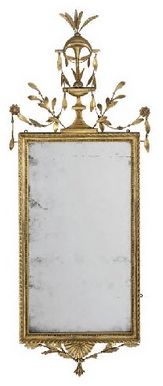
A pier glass or trumeau mirror is a mirror which is placed on a pier, i.e. a wall between two windows supporting an upper structure. [1]
It is therefore generally of a long and tall shape to fit the space. It may be as a hanging mirror or as mirrored glass affixed flush to the pier, in which case it is sometimes of the same shape and design as the windows themselves. This was a common decorating feature in the reception rooms of Neoclassical 18th-century houses.
A pier table or console table typically stood below the pier glass; [2] very often these were made as a matching set.
Trumeau mirrors

A trumeau mirror is a type of wall mirror originally manufactured in France in the later 18th century. It takes its name from the French word trumeau, which designates the space between windows. Such a mirror, usually rectangular, could also hang above an overmantel. A decorative carved or painted scene was the prominent characteristic, and could dominate the actual mirror. [3]
Notes
- ^ "Definition of Pier Glass by Merriam-Webster". Merriam-Webster. Retrieved 17 March 2017.
- ^ Ralph Edwards (1974). The Shorter Dictionary of English Furniture: From the Middle Ages to the Late Georgian Period. Country Life Books. p. 364. ISBN 0600430820.
- ^ Mark Hinchman (2 January 2014). The Fairchild Books Dictionary of Interior Design. A&C Black. p. 193. ISBN 978-1-60901-534-3.